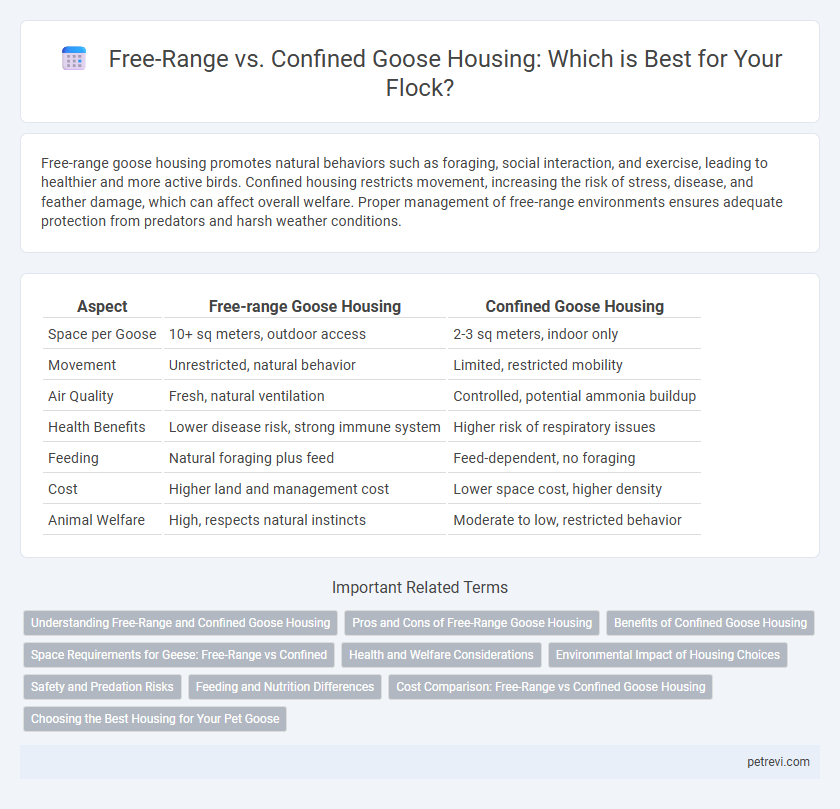Free-range goose housing promotes natural behaviors such as foraging, social interaction, and exercise, leading to healthier and more active birds. Confined housing restricts movement, increasing the risk of stress, disease, and feather damage, which can affect overall welfare. Proper management of free-range environments ensures adequate protection from predators and harsh weather conditions.
Table of Comparison
| Aspect | Free-range Goose Housing | Confined Goose Housing |
|---|---|---|
| Space per Goose | 10+ sq meters, outdoor access | 2-3 sq meters, indoor only |
| Movement | Unrestricted, natural behavior | Limited, restricted mobility |
| Air Quality | Fresh, natural ventilation | Controlled, potential ammonia buildup |
| Health Benefits | Lower disease risk, strong immune system | Higher risk of respiratory issues |
| Feeding | Natural foraging plus feed | Feed-dependent, no foraging |
| Cost | Higher land and management cost | Lower space cost, higher density |
| Animal Welfare | High, respects natural instincts | Moderate to low, restricted behavior |
Understanding Free-Range and Confined Goose Housing
Free-range goose housing allows geese to roam outdoors, promoting natural behaviors and access to fresh forage, which enhances their overall health and well-being. Confined housing restricts movement within enclosed spaces, often used to control environmental factors and prevent predation but may increase stress and limit physical activity. Choosing between free-range and confined systems depends on factors like farm size, climate, and management goals to ensure optimal goose welfare and productivity.
Pros and Cons of Free-Range Goose Housing
Free-range goose housing allows geese to exhibit natural behaviors such as foraging, swimming, and socializing, which promotes better physical health and reduces stress levels. However, free-range systems require more space, increased predator protection, and can result in higher exposure to diseases and parasites compared to confined housing. Managing nutrition and environmental conditions in free-range setups demands careful planning to optimize goose welfare and productivity.
Benefits of Confined Goose Housing
Confined goose housing offers enhanced biosecurity by reducing exposure to predators and disease, leading to healthier flocks and lower mortality rates. Controlled environments enable precise management of diet and water, optimizing growth and egg production efficiency. Space-saving design in confined systems supports higher stocking densities, increasing overall productivity per area compared to free-range setups.
Space Requirements for Geese: Free-Range vs Confined
Free-range geese require significantly more space, typically 25-30 square feet per bird, to allow natural foraging and movement compared to confined systems, where space can be as limited as 4-6 square feet per bird. Providing ample outdoor grazing areas in free-range housing supports better health and natural behaviors, while confined housing demands careful management to prevent overcrowding stress and health issues. Space allocation directly impacts growth rates, feather condition, and overall welfare of geese in both housing types.
Health and Welfare Considerations
Free-range goose housing promotes natural behaviors such as foraging, swimming, and social interaction, which significantly enhance their physical health and psychological welfare. Confined systems often lead to stress, increased disease transmission, and physical ailments like footpad dermatitis due to limited space and poor ventilation. Ensuring adequate space, access to outdoor environments, and proper hygiene is crucial for maintaining optimal health and welfare in goose production.
Environmental Impact of Housing Choices
Free-range goose housing significantly reduces environmental impact by promoting natural foraging, which enhances soil health and biodiversity through manure distribution and vegetation control. Confined housing often leads to concentrated waste accumulation, increasing risks of soil and water pollution and necessitating more intensive waste management practices. Choosing free-range systems supports sustainable farming by lowering the carbon footprint and improving ecosystem balance.
Safety and Predation Risks
Free-range goose housing increases exposure to predators such as foxes, raccoons, and birds of prey, requiring robust fencing and secure nighttime shelters to minimize losses. Confined housing reduces predation risk but demands vigilant management of ventilation, space, and cleanliness to maintain goose health and prevent stress-induced behaviors. Safety measures in both systems must balance predator protection with animal welfare to optimize survival and productivity.
Feeding and Nutrition Differences
Free-range geese exhibit more natural foraging behaviors, resulting in a diet rich in grasses, insects, and aquatic plants, which enhances nutritional diversity and promotes better overall health. Confined geese rely predominantly on formulated feed that ensures consistent nutrient intake but may lack the variety of natural forage nutrients found in free-range systems. Feeding strategies for confined geese often include controlled supplements to meet energy and protein requirements critical for growth and egg production.
Cost Comparison: Free-Range vs Confined Goose Housing
Free-range goose housing typically incurs higher initial land and fencing costs compared to confined systems, where expenses focus on building durable pens and shelters. Operating costs for free-range systems rise due to increased labor for pasture management, while confined housing demands consistent investment in ventilation, cleaning, and waste control. Long-term economic benefits of free-range setups include improved bird health and potentially higher meat quality, which can offset the upfront expenses relative to the more controlled but often less costly confined housing.
Choosing the Best Housing for Your Pet Goose
Free-range housing allows geese to express natural behaviors like foraging, swimming, and socializing, which promotes their physical and mental well-being. Confined housing often restricts movement, increasing the risk of stress, disease, and feather damage in geese. Selecting free-range environments with secure fencing and access to water sources ensures optimal health and happiness for pet geese.
Free-range vs Confined for Goose Housing Infographic

 petrevi.com
petrevi.com